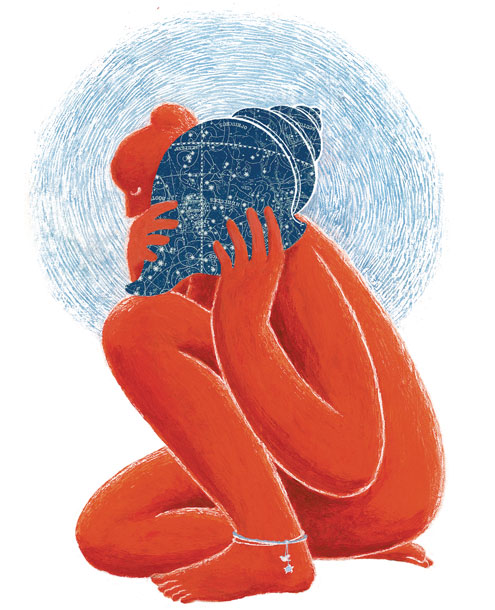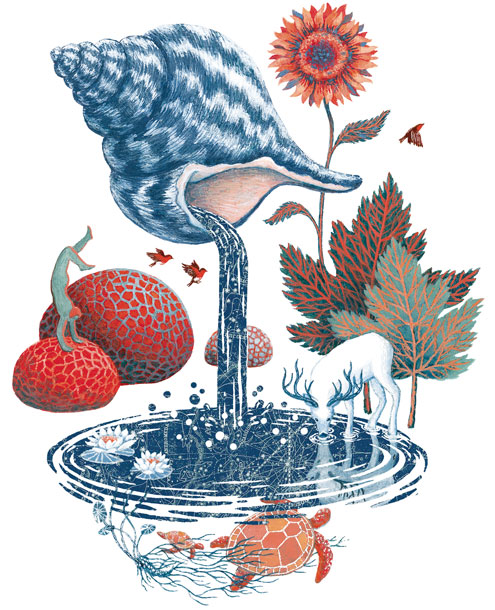
This Article From Issue
January-February 2025
Volume 113, Number 1
Page 58
THE UNIVERSE IN VERSE: 15 Portals to Wonder Through Science & Poetry. Maria Popova and Ofra Amit. 112 pp. Storey Publishing, 2024. $22.00.
The relationship between writers and science is fascinating. Writers gain inspiration, solace, and a sense of wonder from the natural world, as well as areas of science such as physics, biology, mathematics, and astronomy. At the same time, scientific ideas can be illuminated in unexpected ways through poetry. Poetry can be especially adept at capturing aspects of science, with unconventional formatting and styles that mirror the complexity of the sciences.
One collection of poetry that was published in 2024 highlights this relationship in a variety of ways: The Universe in Verse: 15 Portals to Wonder Through Science & Poetry, edited by Maria Popova and illustrated by Ofra Amit, pairs poems with brief glimpses into different science histories.
Poets highlighted in The Universe in Verse include contemporary and classic poets such as Sylvia Plath, Emily Dickinson, Maya Angelou, Adrienne Rich, and Marie Howe. The science histories touch on topics such as Stephen Hawking and singularity, the concept of entropy, radioactivity and Marie Curie, and the cosmos.
The first poem excerpted here, “We Are Listening,” by Diane Ackerman, is paired with a brief discussion of Carl Sagan, the discs known as the Golden Records encoded with music and images and sent into the cosmos aboard the two Voyager spacecraft, and Dr. Jill Tarter, an astronomer known for her work in the search for extraterrestrial intelligence/life (known as SETI). Sagan supported SETI research, and in the film adaptation of his novel Contact, the lead role, astronomer Ellie Arroway, is largely modeled after Tarter.
The second poem is Howard Nemerov’s “Figures of Thought.” In the book, it is paired with a short exploration of mathematician Emmy Noether, the first woman to give the plenary address at the International Congress of Mathematicians in 1932 and the namesake of the 1918 theorem proving that conservation laws rely on symmetry.
Braiding poetry, science, and history, the book lives up to its subtitle, inspiring wonder and piquing curiosity in its readers.
WE ARE LISTENING
Diane Ackerman
I.
As our metal eyes wake to absolute night, where whispers fly
from the beginning of time, we cup our ears to the heavens.
We are listening
on the volcanic lips of Flagstaff and in the fields beyond Boston, in a
great array that blooms
like coral from the desert floor, on highwire webs patrolled
by computer spiders in Puerto Rico.
We are listening for a sound beyond us, beyond sound,

© Ofra Amit
searching for a lighthouse
in the breakwaters of our uncertainty,
an electronic murmur
a bright, fragile I am.
Small as tree frogs
staking out one end
of an endless swamp,
we are listening
through the longest night
we imagine, which dawns
between the life and time of stars.
II.
Our voice trembles
with its own electric,
we who mood like iguanas
we who breathe sleep
for a third of our lives,
we who heat food
to the steaminess of fresh prey,
then feast with such baroque
good manners it grows cold.
In mind gardens
and on real verandas
we are listening,
rapt among the Persian lilacs
and the crickets,
while radio telescopes
roll their heads, as if in anguish.
With our scurrying minds
and our lidless will
and our lank, floppy bodies
and our galloping yens
and our deep, cosmic loneliness
and our starboard hearts
where love careens,
we are listening, the small bipeds
with the giant dreams.
FIGURES OF THOUGHT
Howard Nemerov
To lay the logarithmic spiral on
Sea-shell and leaf alike, and see it fit,
To watch the same idea work itself out
In the fighter pilot’s steepening, tightening turn
Onto his target, setting up the kill,
And in the flight of certain wall-eyed bugs
Who cannot see to fly straight into death
But have to cast their sidelong glance at it
And come but cranking to the candle’s flame—
How secret that is, and how privileged
One feels to find the same necessity
Ciphered in forms diverse and otherwise
Without kinship—that is the beautiful
In Nature as in art, not obvious,
Not inaccessible, but just between.

© Ofra Amit
It may diminish some our dry delight
To wonder if everything we are and do
Lies subject to some little law like that;
Hidden in nature, but not deeply so.
Excerpted from The Universe in Verse © by Maria Popova, illustrated by Ofra Amit, used with permission from Storey Publishing.
American Scientist Comments and Discussion
To discuss our articles or comment on them, please share them and tag American Scientist on social media platforms. Here are links to our profiles on Twitter, Facebook, and LinkedIn.
If we re-share your post, we will moderate comments/discussion following our comments policy.